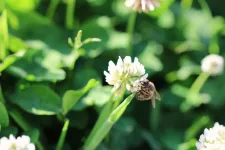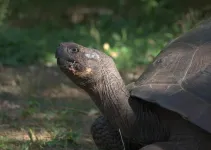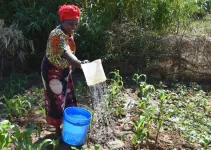They compared this to a 1952 survey of honey plants where a microscope had been used to painstakingly identify pollen grains in honey sent from hives across the country. The differences were clear. White clover had been the most important plant for honeybees but, with fewer pastures today and increased use of herbicides and inorganic fertiliser in farming, this has dropped to second place. Now the insects are visiting much more of: their modern-day favourite, bramble oilseed rape, a plant which has a sting in its tail the highly invasive Himalyan balsam Also important were spring-flowering shrubs and trees,including hawthorn (Cratageus monogyna), apple (Malus species), Cotoneaster species, sycamore and maples (Acer species), cherries and plums (Prunus species), and towards the end of the season, heather (Calluna vulgaris).
Dr Natasha de Vere, Head of Conservation and Research at the National Botanic Garden of Wales, said: "The last 65 years have been a period of profound change within the UK landscape. Agricultural intensification after the Second World War led to a decline in species-rich grasslands and permanent pastures, while hedgerows and woodland were destroyed so that field sizes could increase, and new crops were grown. The distribution and abundance of the UK's wildflowers has changed, with some species declining whilst new plants have been introduced.
"Natural historians, scientists and government agencies have made detailed records over this time, but they are not the only witnesses to this changing world. Honeybees also travel through these landscapes, flying through fields and woodlands, over hedgerows and croplands, searching for nectar and pollen to return to their hives."
The new research: In 2017, Dr Laura Jones repeated a 1952 survey, undertaken by A.S.C. Deans, as part of her PhD research with the National Botanic Garden of Wales and Bangor University. She analysed 441 samples of honey sent in from across the UK. This time, instead of using a microscope, the pollen was identified using plant DNA barcoding, work for which the Botanic Garden has an international reputation.
White clover - in 1952 the most important plant for honeybees was white clover (Trifolium repens). In the new research, white clover was still the second most important plant but there was a significant reduction in its presence within the honey. In 1952 it was found in 93% of honey samples and was a major honey plant in 74% of these, but by 2017 it was found in 62% of samples and was a major source in only 31% - a sign that our modern-day landscape has far less white clover. The Countryside Survey for the UK shows that between 1978 and 2007 white clover decreased within the landscape by 13%. It used to be a dominant plant within permanent pastures and was also often included in grass leys as a source of protein for livestock. Agricultural intensification led to a reduction in the amount of permanent pastures and increased use of inorganic nitrogen fertiliser meant that clover was less likely to be sown in grass leys. Reseeding without clover made it easier to control docks and thistles with a broad-spectrum herbicide that killed off all of the plants that were not grasses. Where white clover was still included in leys, much more regular cutting for silage meant that it was unlikely to be allowed to flower.
Bramble - with the reduction of such an important nectar source, honeybees needed to find alternative supplies of nectar and pollen. The research suggests that honeybees increased the amount of bramble, Rubus fruticosus, in their diets. Bramble and white clover flower at similar times and bramble increased significantly as a major honeybee plant between 1952 and 2017. In 1952, Rubus was found in 58% of honey samples but was a major source in only 5% of these. In 2017, bramble was found in 73% of honey samples and was a major honey plant in 36% of these.
Oilseed rape - first grown in the late 1960s. By 1988, 279,030 ha of oilseed rape (Brassica napus) were in production and this increased to 332,000 ha in 2000. The bright yellow fields are now a common sight in spring. In 1952 the genus Brassica, to which oilseed rape belongs, was a major plant in only 2% of honey samples, by 2017 this had increased to 21%. The presence of Brassica pollen within the honey was found to be significantly greater from hives found within 2 km of oil seed rape crops. Honeybees make full use of the nectar and pollen from oilseed rape and single-origin oilseed rape honey is now widely available. It has a high glucose content that makes it granulate very rapidly into a set, white honey with a mild flavour. The rapid granulation can cause problems for the beekeeper as if it is not extracted rapidly from the combs it can set hard and be impossible to remove. But there is a sting in the tale of this new resource, as oilseed rape seeds are often treated with neonicotinoid insecticides which harm honeybees. These neonic insecticides are currently banned within the UK and hopefully this ban will remain in place.
Himalayan balsam - honeybees in their search for nectar and pollen have also tracked the emergence of an invasive species. Himalayan balsam (Impatiens glandulifera) was first introduced into the UK in 1839. Its fast-growing stature (up to 3 m tall), orchid-like flowers in shades of white, pink and purple, and exploding seed pods, appealed to Victorian gardeners. Himalayan balsam soon made its escape from the garden walls, first spreading slowly, then increasing more rapidly from the 1940s to the 1960s, gradually establishing along waterways and field margins. In 1952 it was present within UK honey at low levels, occurring in 3% of samples with only 1% as a major plant.
Himalayan balsam now rampages along riversides and road verges. In 2017 it was found within 15% of samples and was a major source in 6%. However, this is an under estimation of its importance, since most of the honey samples were provided in July and August, whilst Himalayan balsam tends to be used by honeybees later in the year. Himalayan balsam is now an important late season plant for honeybees, providing an abundant nectar source at a time of year when there is little else available. It helps the bees build up their winter stores and is sometimes sold by beekeepers as a single-origin straw-coloured honey with a sweet, fragrant, floral taste. It is easy to tell when honeybees are foraging on Himalayan balsam as they return to the hive with a characteristic whitewash of pollen covering their bodies, leading them to be called 'ghost bees'.
Himalayan balsam is undoubtedly a good plant for honeybees but this is a controversial issue as it is a highly invasive species listed under Schedule 9 of the Wildlife and Countryside Act 1981, making it an offence to plant or cause this species to grow in the wild. Its vigorous growth means it competes with native plants for light, nutrients and space. It dies back in winter leaving riverbanks bare and open to erosion whilst its dead stems and leaves can block waterways. Even its popularity with pollinators can cause problems, as it can outcompete native wildflowers for their services, leading to reduced seed production in native plants.
Dr de Vere added: "Honeybees and wild pollinators need abundant and diverse sources of nectar and pollen within the landscape, to provide sufficient, high-quality food. By understanding which plants are the most important sources we can provide recommendations on which plants to grow so that honeybees and wild pollinators can thrive."
Recommendations from the research include:
Landscape level changes to provide more floral resources. The UK needs more flower-filled hedgerows with bramble margins and grasslands rich in wildflowers. The conservation of remaining species-rich meadows is a priority, but the area that these habitats cover is vanishingly small.
To make the biggest gains in nectar and pollen, changes are needed in the most prevalent habitat in the UK today - improved grassland. Wildflowers are squeezed out to create grasslands dominated by a small number of grass species, where there are very few flowers to sustain pollinators. But because of the scale of this habitat, small changes here could vastly increase nectar resource. For honeybees providing more white clover in improved grasslands would be best, for other pollinators different flowers are more important.
INFORMATION:





